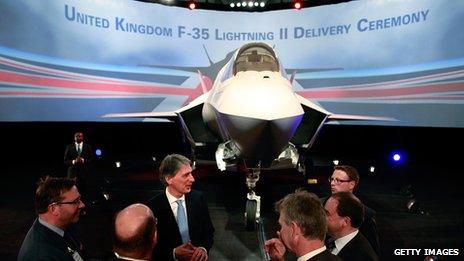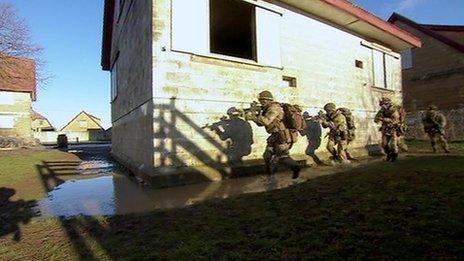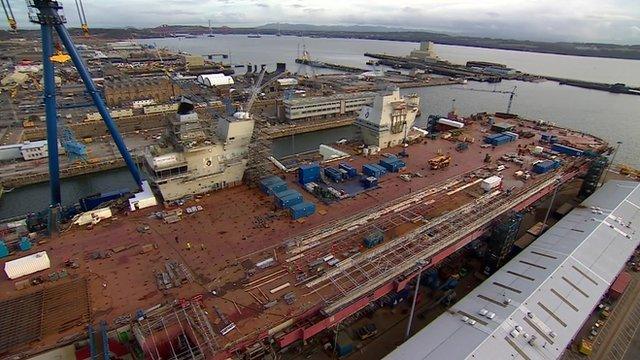Has Britain's defence budget been cut too much?
- Published
Defence correspondent Caroline Wyatt asks whether Britain's defence budget has been cut too far
Has Britain cut defence spending too much in recent years? Are our armed forces stretched too far or should we accept we are no longer a military world power? I decided to find out for The Editors, a programme that sets out to ask challenging questions.
On Monday, the Pentagon revealed plans to scale back the US Army to its lowest level since before World War Two, as the US and Nato forces - including Britain's - edge towards the end of the war in Afghanistan.
The US Defence Secretary Chuck Hagel recommended shrinking US forces from 520,000 to between 440,000 and 450,000, a proposed cut of some 13% by around 2017. Congress must still approve the move.
British forces are undergoing a similar process, with a 20% reduction in regular army numbers from 102,000 to 82,000, between 2010 and 2018, announced following the UK's defence review in 2010, along with a proposed rise in the number of reservists.
The Royal Navy and the RAF were also cut, though by a smaller proportion.
Skilled work
Critics of the 2010 defence review have long argued that the cuts to defence spending left significant gaps, and made the UK a less reliable ally for international partners such as the US.
Above all, they wondered whether the cuts meant the UK had given up on its global ambitions, and its desire to project power beyond these shores.
At a dockyard in Rosyth, in Fife, it would seem those ambitions are far from being abandoned when it comes to the aircraft carriers of the future.
A ship bigger than any the UK has built before is taking shape in the dry dock there, offering skilled work to thousands.
So big is the nation's newest aircraft carrier that one of the future ship's company, Lt Cdr Harvie Montgomery, is working on a GPS system to help its crew navigate the many floors. The ship feels like a small noisy city already, as workers weld and drill.
HMS Queen Elizabeth is due to be handed over in 2017, and the aim is for the Royal Navy to be flying F-35 Lightning II jets from her not long afterwards - if all goes to plan, though both complex projects have suffered delays.
The second carrier, HMS Prince of Wales, should be finished after that, with both ships in the hands of the Royal Navy by the end of 2019.
Yet it is still not clear whether the UK will be able to afford to run both carriers, which might seem odd for a nation that still - just - boasts the world's fourth largest defence budget.
Defence Secretary Philip Hammond says he is keen for the UK to use both carriers, rather than mothball one, but that is a decision for the next defence review.
"My personal view is that having invested well over £6bn in two aircraft carriers, we ought to do everything we can to ensure both are available to the Royal Navy so that we can have a carrier continuously available," he says.
Unequivocal 'yes'
And what of the aircraft to go on board?
"We haven't made final decisions on numbers but we're clear we will need 48 to sustain the carrier force. That's the number we expect to buy," he says.
After years of headlines following the 2010 defence review, which cut 8% from the defence budget and resulted in the sell-off of the Harrier jet force, two of the nation's three aircraft carriers for scrap, as well as thousands of military redundancies, have we cut too deep?

Philip Hammond takes delivery of the first F-35 Lightning II jet at a ceremony in Texas
Former Welsh Guardsman Simon Weston, who suffered terrible injuries in the bombing of the ship Sir Galahad during the Falklands War in 1982, gives an unequivocal "yes".
He still feels a strong connection to the armed forces, and believes passionately that the cuts to the Army have gone too far, from 102,000 to 82,000 regular soldiers by 2018, with a planned boost to the number of trained reservists to 30,000.
"We now have far too few people to do the role. We're relying too heavily on the TA or reservists, as they've tried to rebrand them. And it's not working," he believes.
"The biggest problem is that the cuts and redundancies are being made, but you need to have well-trained regular soldiers to send to any conflict straightaway. If you bring regular numbers down to 80,000, then that really means a fighting force of 20,000 with 60,000 soldiers to support them and carry out logistics," he points out.
"The knife is being pushed too deeply in defence. The Territorial Army have been magnificent, but it takes a heck of a long time to prepare people for war with the skills and the talents needed to be able to serve on the front line. For that, you need regulars. It concerns me greatly," he says.
His concerns are echoed by many still serving within the armed forces but what do defence experts think?
'One-shot force'
Prof Mike Clarke, director general of the Royal United Services Institute, says: "We have full spectrum forces, which mirror American forces but at one-tenth the size, for which we pay about one-tenth the cost.
"But our numbers are now very small, and the question is: can we keep alive a small version of America?"
That debate has already begun ahead of the next defence review, due after the general election in 2015.
Prof Clarke says: "The real problem is that we have a one-shot force. That is, we can send our forces to war, they can go to a conventional war but they can't stay. Is that sufficient? And if we prepare them for a one shot war, as we did in 2003 or the Gulf in 2001, are they then in the right structure to do all the things we want them to do?"
He adds: "We've cut too far for our present level of ambition. We are still a very big military power. We spend the fourth biggest budget in the world, but we don't get the fourth biggest forces for it. So we either have to scale back our ambitions, or we've got to say: it is important to do those things, and - come 2015 - we will spend more on defence, something in the order of £2bn to £3bn more than we were planning to. That is the choice that defence planners face."
'Real argument'
Over the next few years, the Royal Navy will be the beneficiary of much of the current equipment spending in defence, with the carriers, Type 26 frigates, and potentially the submarines to carry the successor to the UK's Trident nuclear deterrent system - another key decision being left for the next government.

British soldiers training on Salisbury Plain for an as-yet-unknown future conflict
"We are on the cusp of a real argument that goes back to something we used to talk about in the 1930s, as to whether we should be predominantly a land power or a maritime power. It's going to be very difficult to say, 'We have elements of everything, we can do it all.' I don't think we can," Prof Clarke believes.
"Informed opinion within the defence business is beginning to line up around whether we need a more overt maritime strategy built around the carriers, or whether we need a ground force strategy with a modernised army with new equipment."
The recent cuts, and last year's vote in Parliament not to engage British forces in Syria also had an impact on opinion abroad.
"That's led people in some other countries to ask - is the UK a serious military player any more? A series of relatively small issues led to the perception that we are not the power or the reliable ally for the US we once were ten years ago," says Prof Clarke, who adds: "I think it's a misperception, but it is there."
'Pedal hard'
When we interviewed Mr Hammond he had just returned from talking to his inundated constituents in Surrey about flood defences.
He has ensured the armed forces took a role in helping the civil authorities, as they did at the London 2012 Olympic Games.
Does he think the defence budget has been cut too far?
"I hope the signal that we're sending is that the UK is committed to living within its means. You can only build a strong and sustainable defence on a strong and sustainable economy," he replies.

The aircraft carrier HMS Queen Elizabeth takes shape in Rosyth
"There is a balance between equipment on the one hand and manpower on the other, and there is a challenge there for the medium term about the balance between equipment spending versus manpower spending," he adds.
Mr Hammond says: "I'd like the defence budget to be bigger. I'd like to have a bigger military, who wouldn't? But where we are at the moment is a position we can sustain.
"It requires hard work and careful management, but it is sustainable. We can deliver the outputs that we're mandated to deliver in Future Force 2020. The budget will allow us to do that. It is not allowing us to put our feet up while we do it. We're having to pedal very hard to make the savings, deliver the efficiencies that make it possible to have that capability within the budget envelope."
And he finished with a warning to the Treasury over any future cuts: "I'm not sure that we'll be able to deliver those outputs if we got much smaller. But at the current level of resource, it is something we can do."
Viewers in England can watch it on BBC One at 23:20 GMT on Monday 24 February or catch it later on the BBC iPlayer.
- Published7 April 2011